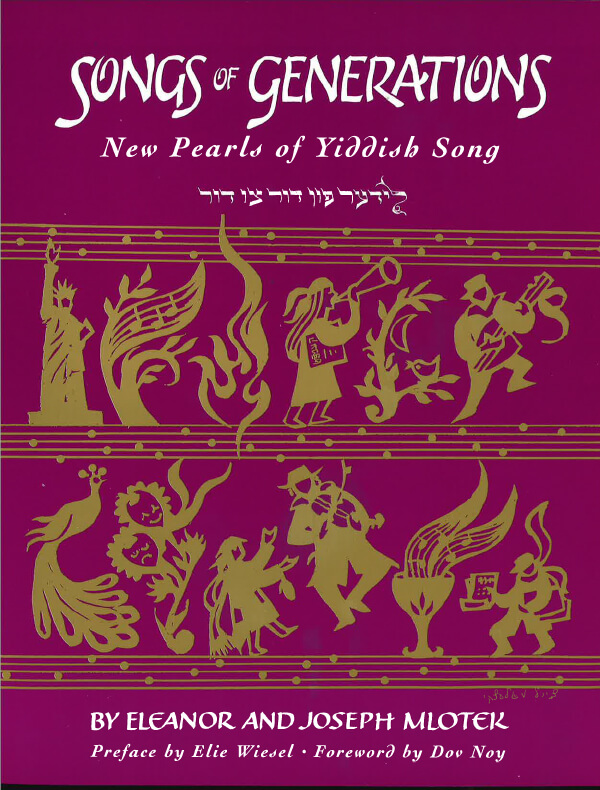Folksong of Jewish farmers in the Crimea in the middle ’20s, published by Moishe Beregovski-ltsik Fefer in 1938. In the YIVO Archives there is a ghetto song of Transnistria which is an adaptation of Dzhankoye (sent in by ltsik Schwartz, Baku, 1948), about an old man who collects corpses from the concentration camp to bring them to the cemetery for burial. The first stanza is:
“Az me geyt keyn obadivke, / lz nit vayt keyn balanivke. / Dortn iz a lagerl faran, / Mentshn lign op mes-lesn /Nish’ getrunken, nish’ gegesn / Fritsl zogt:-azoy dart es zayn!” (When you go to Obadivka, it’s not far from Balanivke, there is a concentration camp. People lie there for days, without drink, without food. Fritz says: that’s how it should be!). A variant collected by Moishe Beregovski and Reuven Lerner was published in Sovetish heymland,1968:4. Also Chava Lapin recalls that in Israel in the 50s; the melody was.sung to the words of “Daroma leElat.”
In recent times the melody of “Dzhankoye” was used in a Purim song by Dmitri Yakirevitch, printed in the bulletin Mame-loshn no. 2, 1989, issued by the Initiative Group of the Yiddish Culture Association in Moscow.

If you travel to Sevastopol,
not far from Simferopol,
there’s a railroad station there.
Who needs to look for new good fortune?
It’s a very special station,
in Dzhankoye, Dzhan, Dzhan, Dzhan.
Hey, Dzhan, hey Dzhankoye,
hey Dzhanvili, hey Dzhankoye,
hey Dzhankoye, Dzhan, Dzhan, Dzhan.
Answer my question, people –
where’s my brother, where’s Abrasha?
His tractor is running like a train.
My Aunt Leah is at the reaper
and Beyle at the thresher,
in Dzhankoye, Dzhan, Dzhan, Dzhan.
Who says Jews only know about trade
and how to eat rich soup with almonds,
but not how to be workers?
Only our enemies can say that.
Jews, spit in their faces –
Take a look at Dzhan, Dzhan, Dzhan.
Az men fort keyn Sevastopol,
lz nit vayt fun Simferopol,
Dortn iz a stantsiye faran.
Ver dart zukhn naye glikn?
S’iz a stantsye an antikl,
In dzhankoye, dzhan, dzhan, dzhan.
Refrain:
Hey, dzhan, hey, dzhankoye,
Hey, dzhanvili, hey, dzhankoye,
Hey, dzhankoye, dzhan, dzhan, dzhan.
Entfert, yidn, oyf mayn kashe,
Vu’z mayn bruder, vu’z Abrashe?
S’geyt bay im der trakter vi a ban.
Di mume Leye bay der kosilke,
Beyle bay der molotilke,
In dzhankoye, dzhan, dzhan, dzhan.
Ver zogt, az yidn konen nor handlen,
Esn fete yoykh mit mandlen,
Nor nit zayn keyn arbets-man?
Dos konen zogn nor di sonim,
Yidn, shpayt zey on in ponem,
Tut a kuk oyf dzhan, dzhan, dzhan!
אַז מען פֿאָרט קײן סעװאַסטאָפּאָל,
איז ניט װײַט פֿון סימפֿעראָפּאָל,
דאָרטן איז אַ סטאַנציע פֿאַראַן,
װער דאַרף זוכן נײַע גליקן?
ס׳איז אַ סטאַנציע אַן אַנטיקל,
אין דזשאַנקױע, דזשאַן, דזשאַן, דזשאַן.
רעפֿרײן:
הײ, דזשאַן, הײ דזשאַנקױע,
הײ, דושאַנװילי, הײ, דזשאַנקױע,
הײ, דזשאַנקױע, דזשאַן, דזשאַן, דזשאַן.
ענטפֿערט, ייִדן, אױף מײַן קשיא,
װוּ ז׳מײַן ברודער, װוּ ז׳אַבראַשע?
ס׳גײט בײַ אים דער טראַקטער װי אַ באַן.
די מומע לאה בײַ דער קאָסילקע,
בײלע בײַ דער מאַלאָטילקע.
אין דזשאַנקױע, דזשאַן, דזשאַן, דזשאַן.
װער זאָגט, אַז ייִדן קאָנען נאָר האַנדלען,
עסן פֿעטע יױך מיט מאַנדלען,
נאָר ניט זײַן קײן אַרבעטסמאַן?
דאָס קאָנען זאָגן נאָר די שׂונאים, —
ייִדן, שפּײַט זײ אָן אין פּנים,
טוט אַ קוק אױף דזשאַן, דזשאַן, דזשאַן.
Song Title: Dzhankoye

The Songs of Generations: New Pearls of Yiddish Song anthology comprises songs that were either never printed before or appeared in rare and inaccessible publications — sometimes in different versions and without proper sources. Most of the songs in this book were submitted by readers of Chana and Yosl’s column “Perl fun der yidisher poezye” (Pearls of Yiddish Poetry) in the Yiddish newspaper Der Forverts (The Forward), initiated in October, 1970. Over 25 years, thousands of songs were collected in correspondence and on cassettes from readers throughout the world, and they represent a veritable national Yiddish song archive. Chana Mlotek, in her introduction, writes, “In the course of years the inquiries, contributions and enthusiasm of these readers have kept our own interest unflagging and have reinforced our dedication to this effort. And in recent years our participants have also been augmented by new readers from the former Soviet Russia, who receive our newspaper there or from newly-arrived immigrants in this country and Israel.”